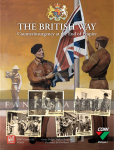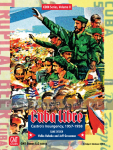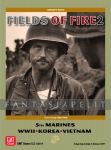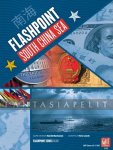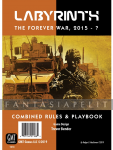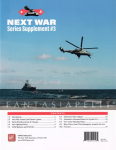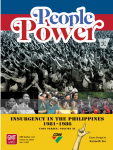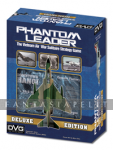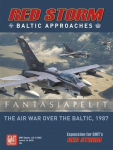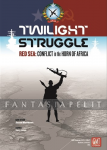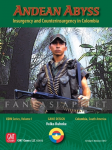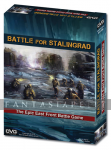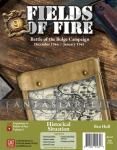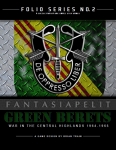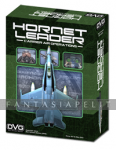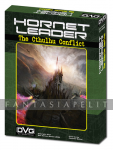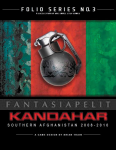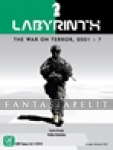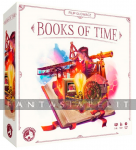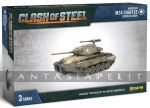The 9th Infantry Regiment “Manchus,” 2nd Infantry Division faced three weeks of intense combat from December 13th, 1944 to January 8th, 1945 as part of the Battle of the Bulge. This campaign covers those critical days. The Campaign consists of seven new missions featuring a new Terrain Deck for the forests, fields, and villages of the Ardennes. The counter sheet includes a U.S. heavy machine gun platoon, Bangalore torpedoes, anti-tank mines, wire entanglements, German tanks, assault guns, Panzergrenadiers, and Volksgrenadiers.
We left the “Manchus” of World War Two in Fields of Fire: Volume I at the close of the Normandy Campaign. The 2nd Infantry Division was rapidly moved to join the assault on the port city of Brest, in Brittany. The city was captured after heavy fighting from August 21st to September 18th. By that time, the German resistance elsewhere in France had collapsed, and the 2nd Infantry Division raced to Paris, arriving on September 29th. The rapid advance ended on October 4th when the Division entered the region just east of St. Vith, Belgium called the Schnee Eifel on the highly symbolic German border. The 2nd Infantry Division relieved the 4th and 28th Infantry Divisions, completing the relief on October 5th. Ahead lay the German border, defended by the Siegfried Line cutting across difficult terrain.
The “Manchus” were able to incorporate replacements and prepare for whatever would come next throughout October and November. This period saw frequent patrol activity but no major combat actions. On December 10th, the 2nd Infantry Division began a relief in place by the 106th Infantry Division. By the 11th, the relief was complete, and the Division gathered at Camp Elsenborn to prepare for the renewed offensive. The attack north through the Siegfried line would commence on December 13th.
Important Note: Fields of Fire Volume I, either first, second, or Deluxe edition is required to play this expansion.
Included Missions:
Wahlerscheid Crossroads “Heartbreak Crossroads” December 13th-16th, 1944
The “Manchus” led the 2nd Infantry Division north to the Wahlerscheid crossroads on the German border. In a cold, wet snowscape the Siegfried line fortifications lay before them. An extensive mined wire entanglement with bunkers and pillboxes covering. Germans planning their major offensive had no idea the Americans would attack in force in this area; their plans only included the inexperienced 99th Infantry Division spread thinly across the German border, which was covering the “Manchus’” right flank. In miserable weather, the “Manchus” were held up and finally rolled up the position in a night infiltration. The morning of the 16th brought news of German attacks along the entire sector.
“Purple Heart Corner” December 17th-18th, 1944
It became clear through the 16th that the German attacks were part of a larger offensive that was beginning to gain ground. This put the 2nd Infantry Division in a precarious position. The decision was made to pull back to prevent from being cut off. The 99th Infantry was slowly crumbling. The “Manchus” raced south toward the twin villages of Rocherath and Krinkelt. Just north of Rocherath, the 1st Battalion reinforced by Company K from the 3rd Battalion was rapidly sent east about a kilometer to the crossroads of farming roads. The Germans were breaking through. As it became dark, the “Manchus” rapidly dug in as best they could. The Germans (thinking the American lines were breached) committed the 12th SS Panzer Division. The fighting through the night and next morning stymied a German breakthrough. Private William Soderman of Company K was awarded the Medal of Honor for his bravery and skill with a bazooka. He personally knocked out three tanks.
“Cat and Mouse Street Fight at Krinkelt” December 18th-19th, 1944
Some Germans fought their way into the twin villages; they sought to secure their foothold in the streets of the villages. Various U.S. units, including the “Manchus,” thwarted their attempts in deadly game of cat and mouse with tanks and bazookas. Unable to hold and unable to bring up reinforcements or supplies, the Germans fell back.
“Last Attacks on Krinkelt” December 19th, 1944
The Germans redirected the 12th SS Panzer Division to the south to bypass the twin villages and follow in trace of the 1st SS Panzer Division that had broken through. Volksgrenadiers were tasked to cover the movement with a series of attacks on the twin villages.
After parrying these attacks, the 2nd Infantry Division moved back to Camp Elsenborn where they started on the 13th. The 12th SS Panzer Division faced a second rebuff at the hands of the 1st Infantry Division. Over the next ten days, the “Manchus” were in reserve rebuilding. Despite heavy shelling, the Germans were stopped cold on their attempts to attack the Elsenborn positions.
“Attack on Bullingen-Hill 629” December 30th, 1944
The German offensive ran out of steam. Ten short days after some of the most desperate fighting ever experienced by the “Manchus,” they transitioned back to the offensive. Striking out from the Elsenborn ridge, the “Manchus” attacked the road junction where the 12th SS Panzer Division was mauled by the 1st Infantry Division. The main German armored units had lost much of their material and were withdrawn. Now a thin screen of Panzergrenadiers and Volksgrenadiers held the lines.
“Attack on Schöneseiffen” January 2nd, 1945
Turning north, the “Manchus” marched through the twin villages and back to the Wahlerscheid crossroads. To their relief, the Germans did not reoccupy the fortifications. The “Manchus” turned right and headed east deeper into German territory. The next major town, Schöneseiffen, was held in force by Panzergrenadiers backed by assault guns and FLAK guns. A tank-infantry attack captured the town.
“Scheuren, Bronsfeld, and Schleiden” January 5th-8th, 1945
Over the next three days, the “Manchus” pushed east towards Schleiden through a series of villagesn and mixed ground. The German resistance was waning, and these actions were the final chapter of the Campaign.
COMPONENTS:
* Campaign Booklet
* Terrain Deck of 55 Cards
* Counter sheet - 176 counters
* One 8.5 x 11Player Aid Card (Vehicle Table/German Squad Breakdowns)








